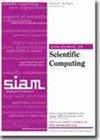非线性薛定谔方程的高阶质量和能量守恒方法
IF 2.6
2区 数学
Q1 MATHEMATICS, APPLIED
引用次数: 0
摘要
SIAM 科学计算期刊》,第 46 卷第 2 期,第 A1026-A1046 页,2024 年 4 月。 摘要。针对非线性薛定谔方程,提出了一类基于时间高斯配位和空间有限元离散的高阶质量和能量守恒方法,在每个时间级引入质量和能量校正后处理。证明了数值解的存在性、唯一性和高阶收敛性。其中,[math]和[math]分别表示时间和空间的有限元度,它们可以任意大。我们提供了几个数值示例来说明所提出的新方法的性能,包括质量和能量守恒以及在模拟孤子和双孤子时的高阶收敛性。计算结果的可重复性。本文被授予 "SIAM 可重现徽章":代码和数据可用",以表彰作者遵循了 SISC 和科学计算界重视的可重现性原则。读者可以在 https://github.com/jiashhu/ME-Conserved-NLS 和补充材料(ME-Conserved-NLS-main-2-Reproducibility-badge.zip [14.4MB])中获得代码和数据,以重现本文的结果。本文章由计算机程序翻译,如有差异,请以英文原文为准。
High-Order Mass- and Energy-Conserving Methods for the Nonlinear Schrödinger Equation
SIAM Journal on Scientific Computing, Volume 46, Issue 2, Page A1026-A1046, April 2024.
Abstract. A class of high-order mass- and energy-conserving methods is proposed for the nonlinear Schrödinger equation based on Gauss collocation in time and finite element discretization in space, by introducing a mass- and energy-correction post-process at every time level. The existence, uniqueness, and high-order convergence of the numerical solutions are proved. In particular, the error of the numerical solution is [math] in the [math] norm after incorporating the accumulation errors arising from the post-processing correction procedure at all time levels, where [math] and [math] denote the degrees of finite elements in time and space, respectively, which can be arbitrarily large. Several numerical examples are provided to illustrate the performance of the proposed new method, including the conservation of mass and energy and the high-order convergence in simulating solitons and bi-solitons. Reproducibility of computational results. This paper has been awarded the “SIAM Reproducibility Badge: Code and data available” as a recognition that the authors have followed reproducibility principles valued by SISC and the scientific computing community. Code and data that allow readers to reproduce the results in this paper are available at https://github.com/jiashhu/ME-Conserved-NLS and in the supplementary materials (ME-Conserved-NLS-main-2-Reproducibility-badge.zip [14.4MB]).
Abstract. A class of high-order mass- and energy-conserving methods is proposed for the nonlinear Schrödinger equation based on Gauss collocation in time and finite element discretization in space, by introducing a mass- and energy-correction post-process at every time level. The existence, uniqueness, and high-order convergence of the numerical solutions are proved. In particular, the error of the numerical solution is [math] in the [math] norm after incorporating the accumulation errors arising from the post-processing correction procedure at all time levels, where [math] and [math] denote the degrees of finite elements in time and space, respectively, which can be arbitrarily large. Several numerical examples are provided to illustrate the performance of the proposed new method, including the conservation of mass and energy and the high-order convergence in simulating solitons and bi-solitons. Reproducibility of computational results. This paper has been awarded the “SIAM Reproducibility Badge: Code and data available” as a recognition that the authors have followed reproducibility principles valued by SISC and the scientific computing community. Code and data that allow readers to reproduce the results in this paper are available at https://github.com/jiashhu/ME-Conserved-NLS and in the supplementary materials (ME-Conserved-NLS-main-2-Reproducibility-badge.zip [14.4MB]).
求助全文
通过发布文献求助,成功后即可免费获取论文全文。
去求助
来源期刊
CiteScore
5.50
自引率
3.20%
发文量
209
审稿时长
1 months
期刊介绍:
The purpose of SIAM Journal on Scientific Computing (SISC) is to advance computational methods for solving scientific and engineering problems.
SISC papers are classified into three categories:
1. Methods and Algorithms for Scientific Computing: Papers in this category may include theoretical analysis, provided that the relevance to applications in science and engineering is demonstrated. They should contain meaningful computational results and theoretical results or strong heuristics supporting the performance of new algorithms.
2. Computational Methods in Science and Engineering: Papers in this section will typically describe novel methodologies for solving a specific problem in computational science or engineering. They should contain enough information about the application to orient other computational scientists but should omit details of interest mainly to the applications specialist.
3. Software and High-Performance Computing: Papers in this category should concern the novel design and development of computational methods and high-quality software, parallel algorithms, high-performance computing issues, new architectures, data analysis, or visualization. The primary focus should be on computational methods that have potentially large impact for an important class of scientific or engineering problems.

 求助内容:
求助内容: 应助结果提醒方式:
应助结果提醒方式:


